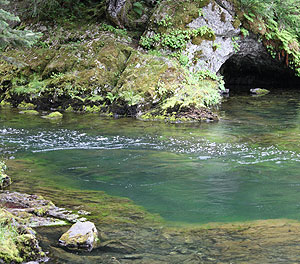Unit 1: Oceans & Rivers
Many ecological, social, and cultural relationships exist and are interdependent.
Lesson Plan 1 - The Water Cycle “Replenishing with Fresh Water”

Summary: The water cycle demonstrates the continuous movement of water on Earth; from the oceans to the atmosphere, through the watershed and back again to the ocean. This cycle is important in understanding the Chugach region, and why it is a temperate rainforest. Through this investigation students will explore and develop an understanding of the water cycle.
Grade Level:
K-4, 5-8, 9-12
Time required:
Ten class periods of 45-60minutes
Materials needed:
• Maps of the local area, state, and world
• Poster board/construction paper
• Markers, colored pencils, or other art materials
• Science journals
• Garden watering can
• Digital cameras
Learning objectives:
• Students will develop an understanding of the water cycle and recreate a labeled diagram.
• Students will correctly define and use basic vocabulary terms associated with the water cycle (collection, evaporation, condensation, precipitation, etc.).
• Students will be able to identify the various ways water is used in their local environment.
• Students will identify and discuss the environmental impact of their own use of water in their area.
Vocabulary introduced:
Cycle, evaporation, conservation, condensation, precipitation, collection
National Science Education Standards:
Earth and Space Science
Content Standard D: As a result of their activities in grades K-4, all students should develop an understanding of the following:
• Properties of earth materials
• Objects in the sky
• Changes in earth and sky
Content Standard D: As a result of their activities in grades 5-8, all students should develop an understanding of the following:
• Structure of the earth system
• Earth’s history
• Earth in the solar system
Content Standard D: As a result of their activities in grades 9-12, all students should develop an understanding of the following:
• Energy in the earth system
• Geochemical cycles
• Origin and evolution of the earth system
• Origin and evolution of the universe
Alaska State Standards:
Concepts of Earth Science
A student should understand and be able to apply the concepts, processes, theories, models, evidence, and systems of earth and space sciences.
A student who meets the content standard should be able to develop the following:
• An understanding of Earth’s geochemical cycles;
• An understanding of the origins, ongoing processes, and forces that shape the structure, composition, and physical history of the Earth;
• An understanding of the cyclical changes controlled by energy from the sun and by Earth’s position and motion in our solar system; and
• An understanding of the theories regarding the origin and evolution of the universe.
Background Information:
Take notice of the natural environment of the school area and know the source of community drinking water. Become familiar with both the western and Indigenous names of local fresh water bodies (rivers and lakes) that drain into the Gulf of Alaska.
Find local beliefs regarding the water or legends that have been told to share with the students.
Invite an elder to talk to the students about the importance of rivers and the ocean to tribal ways of life. With the help of the elder, discuss how the water cycle changes with the seasons. Meet the elders/cultural bearers prior to their visit to the classroom so they understand what you would like them to share and let them become familiar with the classroom.
Have water or tea for the elder/cultural bearer to drink during their visit to the classroom.
Review social expectations with the class prior to the guest speaker (sitting respectfully listening to stories, waiting until the speaker has finished talking before asking questions, offering assistance/escorting when the speaker is leaving).
Have a small gift of thanks for the guest (something made by the class, or a card, and follow with a letter from the students).
Resources: Alutiiq Words
Water and Weather Related Terms
| Water | meq |
| Get Water | mertarluni |
| Hot Water | kulacaq |
| Rain Water | kucitaq |
| River | kuik |
| Lake | nanwaq |
| Lagoon | nanwarnaq |
| Land | nuna |
| Fog (from ocean) | umek |
| Fog (from lakes,mountains) | taituk |
| It's foggy | umgaa |
| Moisture | mecuq |
| Ice | cikuq |
| Melt | uruglluni |
| Rain | qiteq |
| It is raining | qiterluni |
| Sky | qilak |
| Snow (falling) | qaniq |
| Snow (on the ground) | aniuq |
| It is snowing | qanirluni |
| Cloud | amirluq |
| Cloudy, be cloudy | taluluku |
(From Nanwalegmiut Paluwigmiut-llu Nupugnerit – Conversational Alutiiq Dictionary, Kenai Peninsula Alutiiq by Jeff Leer, 1978)
Resources: Literature, audio, video, other curriculum
Literature
• Lethcoe, Jim. The Weather and Climate of Prince William Sound. 2003.
• Lethcoe, Jim. An Observer’s Guide to the Geology of Prince William Sound, Alaska. 1990.
• Locker, Thomas. Water Dance. 2002.
• Martin, Bill Jr. & Archambault, John. Listen to the rain. 1988.
• McKinney, Barbara. A Drop Around the World. 1998.
• Mundy, Philip R, ed. The Gulf of Alaska: biology and oceanography. Alaska Sea Grant College Program, University of Alaska Fairbanks 2005. (Electric copies sent to schools)
• Relf, Pat. The Magic School Bus Wet All Over: A Book about the Water Cycle. 1996.
• Waldman, Neil. The Snowflake: A Water Cycle Story. 2003.
Video
• Water Cycle video: http://www.neok12.com/Water-Cycle.htm
• Water Cycle video: http://teacher.scholastic.com/activities/studyjams/water_cycle/
Other curriculum
• Culture, History and Heritage of the Chugachmiut, Level 1, Grades Pre K-K, Understanding the differences in the tides, Subsistence, Lesson 5 (Fresh and salt water), p. 118 - 119.
• Culture, History and Heritage of the Chugachmiut, Level 2, Grades 1-3, Lost in the Woods, Outdoor Survival, Lesson: Safe Drinking Water, p. 118 - 119.
• Teacher’s Domain: Cycling Water Through the Environment. Grades 3-5.
• http://www.teachersdomain.org/resource/ess05.sci.ess.watcyc.lp_watercycle/
• Teacher’s Domain: Safeguarding Alaska’s Waters (Prince William Sound, EVOS) http://www.teachersdomain.org/resource/ean08.sci.ess.watcyc.contaminants/
• Alaska Seas and Rivers Curriculum: Where does my water come from? Grade 3. http://seagrant.uaf.edu/marine-ed/curriculum/grade-3/investigation-1.html?task=view
• Alaska Seas and Rivers Curriculum: Where does Our Water Go? Grade 3. http://seagrant.uaf.edu/marine-ed/curriculum/grade-3/investigation-2.html?task=view
SmartBoard
• Bodies of Water. Students (K-2) will learn different bodies of water including stream, river, lake and ocean. http://exchange.smarttech.com/details.html?id=57176783-1f2d-42b4-a3e4-f12ad67db0b6
• Water Cycle. Students (1-5) will learn the basics, stages and significance of the water cycle through different activities. http://exchange.smarttech.com/details.html?id=e1b90004-c0d5-48f6-b6e0-bb8f981721b7
Procedure:
Engagement
• Take students on a walking field trip to observe the sky and nearby bodies of water.
• Have the children map their community and show where the bodies of water are. Detail the map to tell what uses each of those bodies of water have; i.e. stream where salmon spawn, where drinking water is collected from, etc. Have older students map out the drinking water and sewage water pathways through the community. Take a tour of the water plant and water collection area.
• Ask students:
- “Where does the rain come from and how did that water get up into the sky?”
- “Where do all the puddles go after the rain?”
- “What is the stuff that fogs up windows?”
• Have students fill out a poster KWL (What we Know, What we Would like to learn, and What we have Learned) chart on the water cycle. Refer back to this chart adding new information at the end of each lesson.
• Discuss posters that display diagrams of the water cycle.
Exploration
• Have the student’s journal their water use between home and school.
• Select three student photographers that live in different places to take photos between their home and school representing different uses of water in the community. Print the photographs or display them in a slide show.
- How would you classify the water use in the photograph?
- Does your family use water in this way?
- Does the water use have an overall positive or negative impact on the local environment? How does the water use impact global water supplies or water quality?
- What is the social impact of the water use?
- What are some possible solutions to lessen the impact of that water use?
• Simulate a rain cloud using a garden watering can and observe where the water goes once it is on the ground.
- What do you notice once the water hits the ground?
- Where does on the water come from in the “cloud”?
- Where will the water on the ground go?
• Ask students to journal on the “rain cloud” simulation or illustrate what happened explaining where the water will go.
• Have students brainstorm various bodies of water and discuss where the water goes and where it came from.
- Use a map to trace where they believe the water goes.
Explanation
• After the rain cloud simulation have students do further Internet research on where the water comes from to form the clouds and/or where the water goes once it is on the ground after raining.
• Have students compare and contrast the water use photographs.
- What are the differences in water use among the photographs?
- Are you connected to the water use in the community?
- What is your personal impact on water use?
• Have the students write essays on their water use.
• Have the students use the vocabulary words in the correct context.
• Show one of the water cycle videos for students to see and hear the process.
• List all of the uses of water on butcher paper that students encounter between home and school.
• After a class discussion on information gathered from their research, have the students illustrate their findings in a poster of their community’s water cycle to share in class, explaining their posters.
• Have the students write a paragraph explaining the four phases of the water cycle shown in the diagram.
Elaboration
• Invite an elder to talk to the students about the importance of rivers and oceans to tribal ways of life.
• With the help of the elder, discuss how the water cycle changes with the seasons.
Evaluation
• Student participation as observed by the teacher
• Water use essays
• Student journal
• Student posters displaying the water cycle with explanation paragraph
• Student use of lesson vocabulary words in correct context
Follow Up Activities:
• Write a song on the water cycle.
• Perform a short skit on the water cycle.
• Write thank you letters to the invited Elders.
• Have the students create their own simulation of rain.
• Have the students do presentations showing their water use photographs to other classes.
• Have students conduct further individual research on water use and its impact on the community.
• Have students identify their local watershed.
• Produce fresh water from salty water by distilling it.
• How does the local hatchery operate? Find out about the local or regional fish or shellfish hatcheries. Contact or visit the Alutiiq Shellfish Hatchery in Seward.
• Discuss global fresh water problems and challenges with the class.
